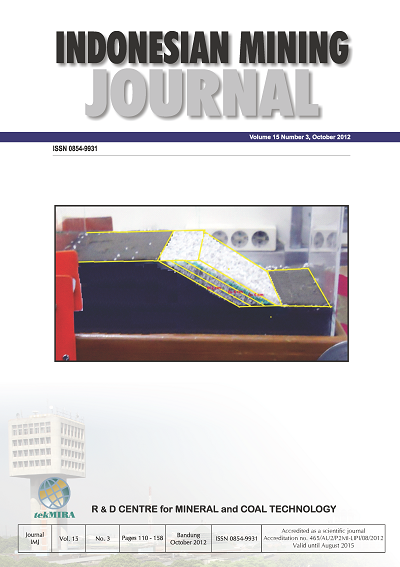IMPACTS OF ARTISANAL GOLD MINING AND EFFORTS TO MINIMIZE NEGATIVE IMPACTS TO THE ENVIRONMENT
DOI:
https://doi.org/10.30556/imj.Vol15.No3.2012.451Keywords:
artisanal gold mining, small scale mining, amalgamation, retort, impact, environment, concentrationAbstract
Indonesia has extensive primary and secondary gold ore deposits that are scattered at several islands. The processing method for gold includes cyanidation, amalgamation and gravity concentration. Amalgamation is one of the most dangerous methods that pollutes the environment. The process is conducted by artisanal gold mining extensively throughout the country and involving around 100.000 miners. The process is started by crushing the ore up to 2-3 cm, then put in the trommel along with Hg and water. The trommel is then rotated for 4-5 hours to produce amalgam (Au-Hg) to be separated from its tailing by panning. The clean Au-Hg, mixed with liquid Hg, is then squeezed to separate the Hg excess. The Au-Hg, mixed with borax is then burnt in a crucible to evaporate its Hg and get the golds bullion (Au-Ag metal). The gold is obtained after the silver within the bullion is leached by HNO3 equipment used for burning the Au-Hg is an open vessel that is operated in the kitchen at which the people also cook the food. This condition is very dangerous for the miner and their families as the Hg vapor is very toxic and can damage human lung. Another problem is that Hg-containing fine tailings are directly discharged to the river. This mercury can pollute the aquatic system and become dangerous for human through food chain. The efforts decreasing the negative effect of artisanal mining employ a retort to burn the amalgam, centralize the trommels; concentrate the gold ores prior to amalgamation. Jig, shaking table, sluice box can be used for upgrading the gold. If tailing with relatively high gold content would be processed by gravity concentration or cyanidation, the location for tailing gold processing should be safe and far from the river and houses.
References
Beinhoff, C., 2007, Removal of barriers to the abate- ment of global mercury pollution from artisanal gold mining, Global Mercury Project, United Nations Industrial Development Organization (UNIDO), Vienna/Austria, p. 1-4.
Darmutji, S.T. 2003, Overview of project site in Indone- sia Talawaan and Galangan areas, Global Mercury Project, December 2003, p. 7-17.
Hinton, J. J., Veiga, M. M.. and Veiga, T.C. 2003, Clean artisanal gold mining: a utopian approach?, Journal of Cleaner Production 11 (2003), p. 99–115.
Husaini, Yunianto B., dan Sujarwanto, 2010, Inves- tigation of mining and processing of gold ores in Poboya, Palu, September 2010 (unpublished material).
McCartor, Andrew J.D. and Becker, Dan B.A. , 2010, Top six toxic threats six pollutants that jeopardize the health of tens of millions of people lead, mer- cury, chromium, arsenic, pesticides, radionuclides, World´s Worst Pollution Problems Report 2010, Blacksmith Institute in partnership with Green Cross Switzerland, p.19-55.
Mutaalim, 2006, The amalgamation and sluicing pro- cesses to minimize mercury losses in Bolaang Mongondow, North Sulawesi (unpublished mate- rial).
Sumual, Herry, 2009, Characterization of the traditional gold mining in Dimembe, North Minahasa, Agritek Vol. 17, No. 5, September (2009), p. 164-168.
Tahli, L., 2009, Teknologi pengolahan emas, Puslit- bang Teknologi Mineral dan Batubara, Bandung, p.10-60.
Telmer, T. and Stapper, D., 2007, Evaluating and moni- toring small scale gold mining and mercury use: building a knowledge-base with satellite imagery and field work UNIDO PROJECT EG/GLO/01/G34, FINAL REPORT November 2007 Aqueous Geo- chemistry Laboratory, School of Earth and Ocean Sciences, University of Victoria, p.19-30.
Veiga, M. M., Baker, R.F, 2006, Removal of barriers to introduction of cleaner artisanal gold mining and extraction technologies, Protocols for Environmen- tal and Health Assessment of Mercury Released by Artisanal and Small-Scale Gold Miners, Project EG/ GLO/01/G34, Global Mercury Project, Coordination Unit, Vienna, UNIDO, p.6-26.
Veiga, M. M., Baker, R.F., Metcalf, S. M., Klein, B., Davis, G., Bamber, A., Singo, P., 2006, Removal of barriers to introduction of cleaner artisanal gold mining and extraction technologies, manual for training artisanal and small-scale gold miners, Project EG/GLO/01/G34, Global Mercury Project, Coordination Unit, Vienna, UNIDO, p.16-50.
Downloads
Issue
Section
License
Indonesian Mining Journal provides immediate open access to its content on the principle that making research freely available to the public to supports a greater global exchange of knowledge.

This work is licensed under a Creative Commons Attribution-NonCommercial 4.0 International License.













